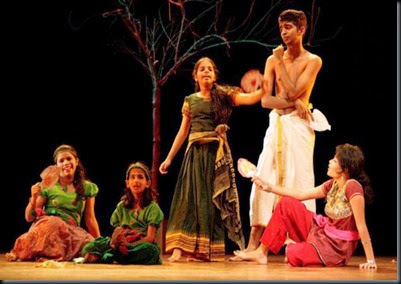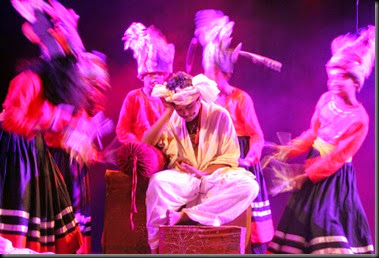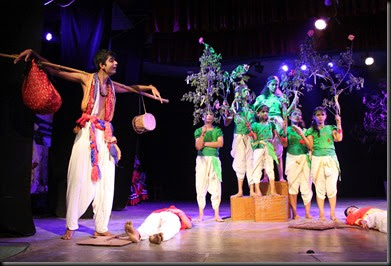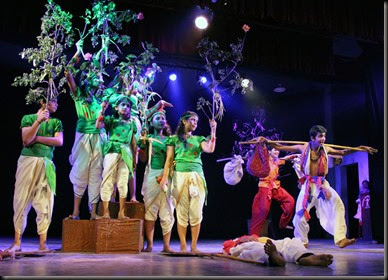Out of Crèche
DIWAN SINGH BAJELI
As Jashn-e-bachpan comes to a close in New Delhi, a look at plays that stood out in the 12-day festival of theatre for children.
Jashn-e-bachpan, the National Theatre Festival For Children, organised by Theatre-in-Education, National School Of Drama on its campus ended with the staging of two plays – “Hum Ek Hain” and “Swami Vivekanand” – this past week, which marked a great leap towards coming of age of the children theatre movement in the Capital.
Arguably, for the first time on Delhi stage a record number of several thousand audiences witnessed 12-day festival featuring 30 plays in different languages at three venues – Abhimanch, Bahumukh and open-air lawns. What is most heartening is the presence of children belonging to different social strata. Special arrangements were made to bring children from schools to the venue of the festival.
The NSD campus, which was given a festive look by Bansi Kaul, eminent stage director and designer, was full of life and colour. One of the laudable aspects was even the plays in regional languages were staged to a capacity hall, thanks to their aural and visual charm and brilliance of the direction. If creative efforts like Jashn-e-bachpan are made on a large scale, covering regions across the country, it will make children theatre a cultural and educational force. This was also an occasion to celebrate the silver jubilee year of TIE – Bal Rang Toli, which has been striving for artistic excellence in plays for children and building up audiences for these dramatic arts.
The plays marked a variety of presentational styles and genres. Though some were specially tailored for children, the majority of productions were sophisticated and some dealt with serious issues that plague Indian society. The dominant impression one had after seeing most of the plays with the child audience was one of the thematic variety reflecting the change in Indian theatre for children, moving from folktales and fantasy to socially relevant themes that children theatre practitioners earlier used to avoid.
Directed by Danish Iqbal and presented by Sada Arts Society, Allahabad, “Hum Ek Hain” deals with communal violence that affects every aspect of social and economic life of the people, especially rupturing the life of the children and women, giving way to living in ghettoes. An adaptation from “Par Humein Khela Hai”, the play contains some of the situations depicted in the production of the original directed by Mohan Agashe for Theatre-in- Education about three decades ago which was inspired by Grips Theatre, Germany. It’s a kind of a theatre for children that is bold enough to present sharp social antagonism by adult performers for children. This theatre aims at not only to entertain young people but make them aware of social ills that are eating into the vitals of social fabric.
Iqbal’s production enhances its emotional appeal with the use of lyrics set to lively music score by Gagan. The lyrics were written by Iqbal. The production is neat, aptly acted and admirably mounted.
One of the highlights of this year’s festival was the presentation of “Swami Vivekanand”, a puppet play produced by Bhartiya Lok Kala Mandal, Udaipur, Rajasthan founded by Devilal Samar, folklorist and exponent of folk theatrical art and its aesthetic values. Jointly directed by Dr Laique Hussain and Shyam Mali, the script is imaginatively written with focus on the most important episodes from the life of Vivekanand.
Instead of following the usual chronological order of Vivekanand’s life, the play enacts episodes in the form of storytelling by a grandfather to his grandson. The action shifts from present to the past and again to the present. The script is written by Dr Hussain with economy of words, focusing on visuals.
Apart from the powerful moral lesson that the production conveys without being didactic, the fascinating aspects of the play was the creative use of traditional kathputli-puppetry theatre of Rajasthan. The colourful costumes, the finely carved out characters from wood and the dialogue rendered by the puppeteers, perfectly synchronising with the movements of the puppet characters who move with remarkable agility. The production also is an innovative theatrical piece to present a serious play through kathputli which is mostly known for providing entertainment to the children evoking laughter through various antics the puppets perform.
“Kalakar Kee Khoj”, which was staged by Kaladham, Jharkhand under the direction of Goutam Gope, highlights the need for entertainment for children and brings out the inherent creativity in a child by providing him or her a platform. It also shows the necessity of art in social life. The most thrilling sequence of the production is the one in which the children performers present vigorous and lyrical dance, a folk form, in colourful costumes.
Beautiful stage compositions, soulful live music, aesthetically designed costumes and narrative blending folk elements with contemporary concerns make “Thathamaram” (The Parrot Tree) a joyous theatrical experience. Directed by Chandradasan and produced by Lokdharmi-Mazhvillu, Kerala, the production is remarkable for its aesthetic beauty and director’s ability to provide its large cast an opportunity to act in a spontaneous way recreating varied situations which are at once serious and amusing, griping the attention of the audience. The way the story of parrot tree is revealed is fascinating.
Yet another group from Kerala, Rangachetana featured its splendid production “Manthrika Kannadi” that depicts the interesting folk tale to convey the complex message of the necessity of communication between the outer self and inner self of an individual through the metaphor of magical mirror, beautifully rendered songs, performers’ movements, formation of visuals which creates stunningly expressive situations. The production thrills, amuses and makes aware the audience to explore the inner moral self to protect oneself and society from the onslaught of vulgar materialistic forces. It is directed by K.V. Ganesh, the script writer and artistic director of Rangachetana.
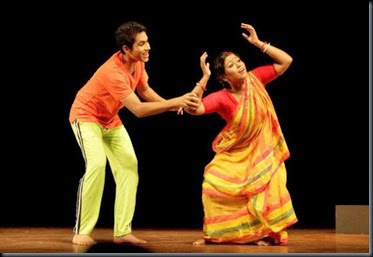 Nandikar, Kolkata presented “Kanu”, which is based on a Vietnamese short story entitled “A Manly Boy” (Kiem) by Ma Van Khang which is directed by Swatilekha Sengupta. Intensely dramatic, imbued with vitality, the play is cantered round the life of Kanu, a young boy who loves his freedom and his trials and tribulations in the course of life’s journey through a world full of violence, apathy and faceless vindictive forces.
Nandikar, Kolkata presented “Kanu”, which is based on a Vietnamese short story entitled “A Manly Boy” (Kiem) by Ma Van Khang which is directed by Swatilekha Sengupta. Intensely dramatic, imbued with vitality, the play is cantered round the life of Kanu, a young boy who loves his freedom and his trials and tribulations in the course of life’s journey through a world full of violence, apathy and faceless vindictive forces.
Entertaining, educative and playful are the words that convey the essence of Bharari (non-verbal) presented by Natyashala Charity Trust, Mumbai under the joint direction of Bharat More and Anvay Ashtivikar. Though the play depicts the evolution of man from primitive stage to modern one through movements, mime, stage compositions, the serious account is revealed with liveliness. A lyrical undercurrent runs throughout the show projecting different stages of the development of human civilization. The mime part is enacted by hearing-impaired performers, displaying remarkable agility.
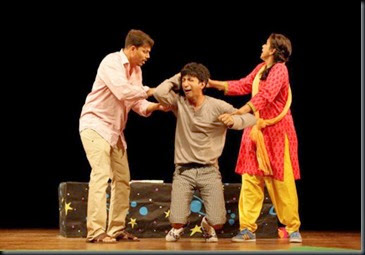 One of the best productions of the festival was “The Boy Who Stopped Smiling” presented by Working Title, Mumbai and directed by Jaimini Pathak that has striking relevance to problems of youngsters and a satire on an insensitive society unable to understand the psyche of young people. The production is sleek, highly educative offering hilariously funny moments to the audience. It has all the elements – lyrics set to lively tunes, simple and delightful dance movements, suspense, pathos and happy ending – the children simply love to enjoy. The moments of acute anxieties are juxtaposed with light-hearted hilarity and the acting style ranges from realistic to farcical. The writer is Ramu Ramunathan of Comorade Kumbhkarna fame who deserves praise for his significant dramatic piece.
One of the best productions of the festival was “The Boy Who Stopped Smiling” presented by Working Title, Mumbai and directed by Jaimini Pathak that has striking relevance to problems of youngsters and a satire on an insensitive society unable to understand the psyche of young people. The production is sleek, highly educative offering hilariously funny moments to the audience. It has all the elements – lyrics set to lively tunes, simple and delightful dance movements, suspense, pathos and happy ending – the children simply love to enjoy. The moments of acute anxieties are juxtaposed with light-hearted hilarity and the acting style ranges from realistic to farcical. The writer is Ramu Ramunathan of Comorade Kumbhkarna fame who deserves praise for his significant dramatic piece.
“Unity is strength” is the message conveyed by Apundna Pangalni with animal characters. Directed by N. Jadumani Singh, the most impressive feature is colourful costumes, variety of masks to represent different variety of animals, including lions and birds. The illusion of a dense forest is created with the creative use of glossy satin in lush green colour illuminated by skilful lighting. It transcends language barrier because of its highly expressive visuals and dramatic action performed by actors in the costumes and masks of wild animals which are favourite with children.
“Geete Gathe Milan Mala” directed by Bhagirathi and presented by Seagull, Assam captures the village life of Assam focussing on an elderly couple and people of the village that assemble daily near a well in front of the house of the couple. It is remarkable for delightful music and delicately rendered dances by women narrating a story with twists and turns.
Mayur Rangmanch, U.P staged “Laakh Ki Naak” under the direction of Shashikant Sharma. A moral parable, it offers the children thoughtful and delightful moments
Courtesy - The Hindu - FEATURES » FRIDAY REVIEW -November 20, 2014
Updated: November 20, 2014 18:10 IST
Labels: Chandradasan, children's Theatre, Lokadharmi, Mazhavillu, nsd, puppet theatre, Thathamaram
